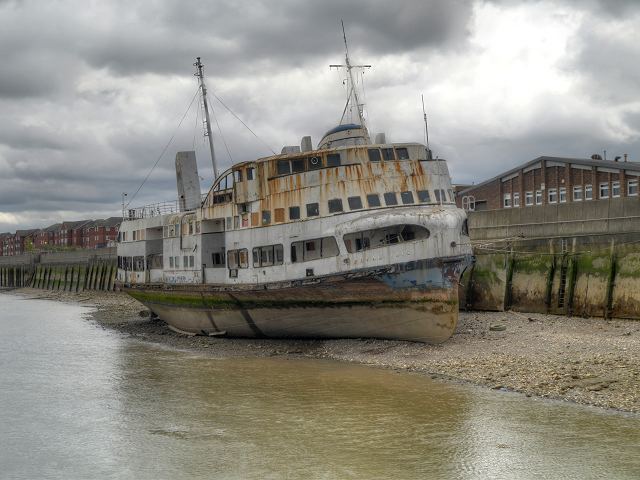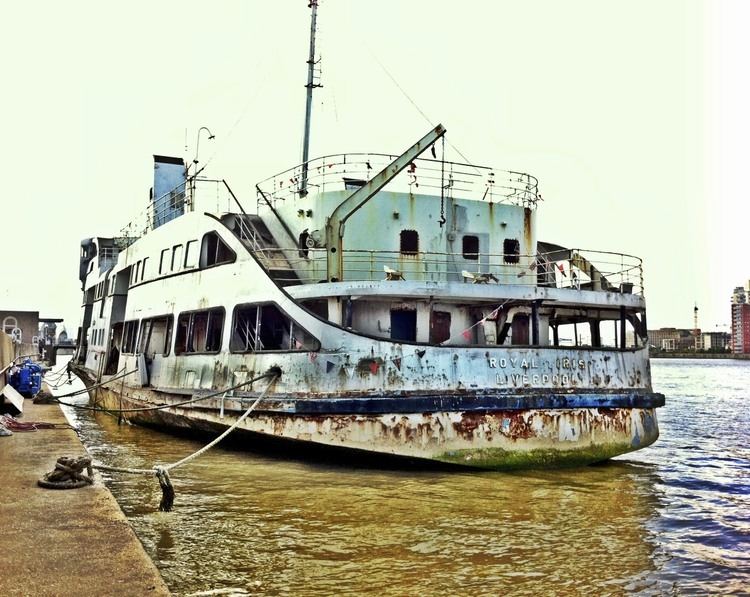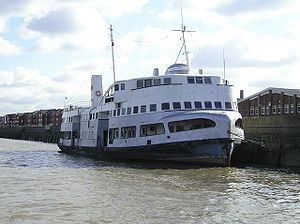Ordered November 1957 Launched 6 July 1959 Draft 2.46 m | Construction started 20 October 1958 Length 46 m | |
 | ||
Name 1959–2001 Mountwood2001 onwards Royal Iris of the Mersey Port of registry 1959 onwards Liverpool, United Kingdom | ||
The MV Royal Iris of the Mersey is a Mersey Ferry in operation on the River Mersey, England. From launch in Devon in 1959 until a major refurbishment in 2001, she was named MV Mountwood.
Contents

MV Mountwood

The Mountwood was the slightly older sister ship of the MV Woodchurch. Both of the ferries were built for the Corporation of Birkenhead to replace the existing fleet of 1930s steamers. The designs of the two new vessels were loosely based on the ferries Leasowe and Egremont of the Wallasey Corporation, they were designed by the same company, Graham and Woolnough and were built at the same shipyard, Messrs. Philip and Sons Ltd. of Dartmouth. Mountwood was launched by Mrs Hugh Platt on the 6 July 1959 into the River Dart, and after being fitted out was delivered to the Mersey in 1960. She was named after an overspill post-war housing development of Birkenhead.

The Mountwood and her identical sister Woodchurch originally had bright orange funnels with a black base and black soot buffer. On the main deck, there was a forward, heated shelter and also a main saloon, aft of this was the toilets and machine space. Below was a saloon bar. On the top deck was a large open promenade and a forward shelter beneath the bridge, although this shelter was open beneath the bridge so it was often breezy and cold. They had a main central wheelhouse and two side cabs, and power came from two medium speed Crossley 8-cylinder diesel engines. Upon the bridge deck, in the wheelhouse, one would find the large brass helm, the hydraulic steering telemotor. a binnacle, and two conjoined Chadburn Synchrostep engine order telegraphs. These were linked to the other two identical telegraphs in the docking cabs so they moved in tandem. There was also whistle controls and lighting controls. In the docking cabs or navigation boxes was another binnacle, a whistle control, telegraphs and also various indicators for engine/speed etc. Originally all ferries had a simple ship to shore communicating radio, but did not have radar or sonar. The wheelhouses of the two ferries differed slightly due to different positioning of rudder angle indicators and engine RPM gauges in the bridge wings. The telegraphs were designed to give the captain direct control of the engines (although they could still be used in the traditional signal / response manner) and as such were marked with commands such as 'brake'and 'start'. They also had more speed settings ahead and astern. The original engines could reach full speed within 3 seconds once 'run' had been passed.

In her early years Mountwood was an unreliable ship, breaking down several times whilst crossing the river and having to anchor. In May 1961, she suffered a main engine failure, with her passengers having to be rescued by Woodchurch. She also collided with Bidston whilst berthing, due to a communications error. The new Mountwood had two options of engine control. The first was direct control, where the bridge telegraphs controlled the engines directly, without the assistance of an engineer at the control board. The second option was the traditional system of telegraph orders between the engineers and the engines. On this day, the Mountwood was operating in the traditional way. The captain gave an order for full astern on the starboard engine to pull the vessel's bow away from the landing stage in preparation for her departure for Liverpool. He then stopped the starboard engine, switching the telegraph to the " run " position (a position where the propeller turns at a very slow rate and most often used to keep the vessel against a landing stage during a strong swell). He then placed the port telegraph to half ahead to push the stern of the vessel clear from the landing stage. What actually happened is unclear, but it seems that the engineer carried out the reverse of the telegraph orders which sent the Mountwood's bow into the stern of the nearby steamer Bidston. There should have been a ‘wrong way’ alarm which sounded however either the engineer failed to hear it or, for some reason, it was not working.

The Mountwood remained in operation up until she was withdrawn for refurbishment in 1989. She was rewired, internally refurbished and her bridge wheelhouse and cabs were plated over to form one large navigation bridge, although she retained all the original equipment. The original Crossley engines were retained but heavily overhauled and the central saloon saw modifications in the form of a cafe. The most noticeable change was the colour of the funnel, flame red and black, harking back to the 1920s Birkenhead steamships. The new 'Mersey Ferries' logo was painted on each side of the funnel. The Mountwood returned to service in July 1990 and remained in operation up until 2001 when she was withdrawn from service for a major refit. Her only major work during the period 1990–2001 was the addition of a shelter abaft the bridge, which also had a small bridge deck area. The black band on the funnel was reduced and the logo resized giving the ferry an oddly small looking funnel.
Major Refit

In 2001, the Mountwood was withdrawn and taken to Birkenhead's former Cammell Laird shipyard (which became owned by A&P), and then to Clarence graving docks, where she was stripped of her fittings and parts of her superstructure were removed and rebuilt. Unfortunately the ferry remained dormant for some time due to problems at the shipyard. She was then re-engined and rebuilt. Noticeable changes were the addition of a new, angle fronted, large wheelhouse and bridge deck, plus her funnel, which was reinstated after the refit, was moved further back to fit with the position of the new engines. Her central saloons were also extended to the full width of the ship. She looks quite similar the Woodchurch's refit to Snowdrop. The ferry contained many items that would be classes as nautical antiques and quite valuable, such as engine telegraphs, binnacles and much brassware. The helm and binnacles were reinstated onto the new bridge, some of the items are now in Mersey Ferries’ archives and the others belong to a private collector. In May 2011 the ferry's nameplate was replaced and it now carried the words 'Royal Iris' in Birkenhead Corporation style script font.
MV Royal Iris of the Mersey
Today the Royal Iris of the Mersey is a regular vessel used on both cross river ferry services and also Manchester ship canal cruises. The ferry has a top speed of 12knots against the incoming tide, however speeds of 16+ knots can be recorded when the ferry is travelling at full speed with an incoming tide. The ferry can't be called "Royal Iris" as the previous vessel of that name (the MV Royal Iris) is still listed on Lloyd's Register of Shipping in the same class. The ferry still retains many features from her days as Mountwood including the original pair of Kockums Supertyfon fog horns, as do her two sister ships.
In October 2011, the vessel underwent a further internal refit. This refit saw the replacement of the interior saloon flooring and new seating throughout the saloons, giving the ferry a much more traditional look. The Merseytravel logo has now been removed from the funnel, which is plain red and black.
Incidents
The vessel has been involved in a number of incidents aside from the collision with Bidston. She had a complete engine failure on two occasions due to a faulty fuel pump and had to anchor in the river when she was brand new.
In popular culture
The Mountwood was used in the film Ferry Cross The Mersey, a musical named after the Gerry & The Pacemakers song. It also appeared in the opening titles for the television series, The Liver Birds. The Royal Iris (of 1951 not the current vessel) is also mentioned in the Paul McCartney song, "That Was Me" from the Memory Almost Full album. "Royal Iris, Meryseybeatin"
